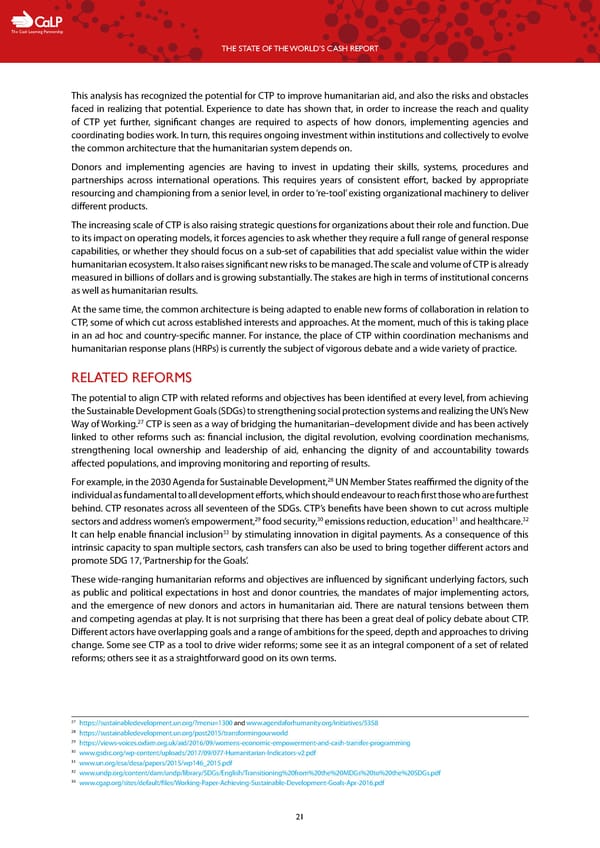C The Cash Learning Partnership THE STATE OF THE WORLD’S CASH REPORT This analysis has recognized the potential for CTP to improve humanitarian aid, and also the risks and obstacles faced in realizing that potential. Experience to date has shown that, in order to increase the reach and quality of CTP yet further, significant changes are required to aspects of how donors, implementing agencies and coordinating bodies work. In turn, this requires ongoing investment within institutions and collectively to evolve the common architecture that the humanitarian system depends on. Donors and implementing agencies are having to invest in updating their skills, systems, procedures and partnerships across international operations. This requires years of consistent effort, backed by appropriate resourcing and championing from a senior level, in order to ‘re-tool’ existing organizational machinery to deliver different products. The increasing scale of CTP is also raising strategic questions for organizations about their role and function. Due to its impact on operating models, it forces agencies to ask whether they require a full range of general response capabilities, or whether they should focus on a sub-set of capabilities that add specialist value within the wider humanitarian ecosystem. It also raises significant new risks to be managed. The scale and volume of CTP is already measured in billions of dollars and is growing substantially. The stakes are high in terms of institutional concerns as well as humanitarian results. At the same time, the common architecture is being adapted to enable new forms of collaboration in relation to CTP, some of which cut across established interests and approaches. At the moment, much of this is taking place in an ad hoc and country-specific manner. For instance, the place of CTP within coordination mechanisms and humanitarian response plans (HRPs) is currently the subject of vigorous debate and a wide variety of practice. RELATED REFORMS The potential to align CTP with related reforms and objectives has been identified at every level, from achieving the Sustainable Development Goals (SDGs) to strengthening social protection systems and realizing the UN’s New 27 Way of Working. CTP is seen as a way of bridging the humanitarian–development divide and has been actively linked to other reforms such as: financial inclusion, the digital revolution, evolving coordination mechanisms, strengthening local ownership and leadership of aid, enhancing the dignity of and accountability towards affected populations, and improving monitoring and reporting of results. For example, in the 2030 Agenda for Sustainable Development,28 UN Member States reaffirmed the dignity of the individual as fundamental to all development efforts, which should endeavour to reach first those who are furthest behind. CTP resonates across all seventeen of the SDGs. CTP’s benefits have been shown to cut across multiple 29 30 31 32 sectors and address women’s empowerment, food security, emissions reduction, education and healthcare. 33 It can help enable financial inclusion by stimulating innovation in digital payments. As a consequence of this intrinsic capacity to span multiple sectors, cash transfers can also be used to bring together different actors and promote SDG 17, ‘Partnership for the Goals’. These wide-ranging humanitarian reforms and objectives are influenced by significant underlying factors, such as public and political expectations in host and donor countries, the mandates of major implementing actors, and the emergence of new donors and actors in humanitarian aid. There are natural tensions between them and competing agendas at play. It is not surprising that there has been a great deal of policy debate about CTP. Different actors have overlapping goals and a range of ambitions for the speed, depth and approaches to driving change. Some see CTP as a tool to drive wider reforms; some see it as an integral component of a set of related reforms; others see it as a straightforward good on its own terms. 27 https://sustainabledevelopment.un.org/?menu=1300 and www.agendaforhumanity.org/initiatives/5358 28 https://sustainabledevelopment.un.org/post2015/transformingourworld 29 https://views-voices.oxfam.org.uk/aid/2016/09/womens-economic-empowerment-and-cash-transfer-programming 30 www.gsdrc.org/wp-content/uploads/2017/09/077-Humanitarian-Indicators-v2.pdf 31 www.un.org/esa/desa/papers/2015/wp146_2015.pdf 32 www.undp.org/content/dam/undp/library/SDGs/English/Transitioning%20from%20the%20MDGs%20to%20the%20SDGs.pdf 33 www.cgap.org/sites/default/files/Working-Paper-Achieving-Sustainable-Development-Goals-Apr-2016.pdf 21
 The State of the World's Cash | Full Report Page 22 Page 24
The State of the World's Cash | Full Report Page 22 Page 24